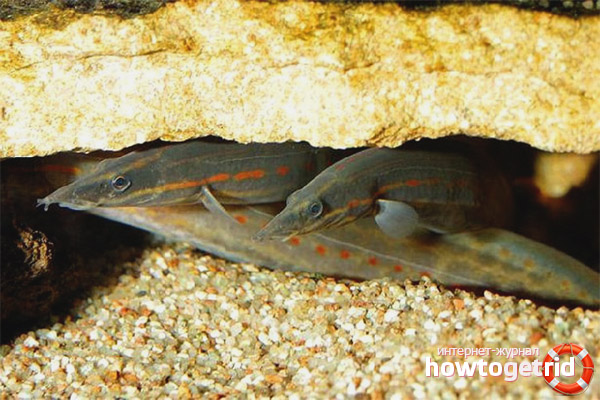The content of the article
The presented breed has an old historical summary, the view was opened in 1800, since then the popularity of the represented individuals only grows. Mastamembela, Valium is valued for external data, the fish in its appearance resembles a snake. An elongated body shape and an impressive color are not all qualities. Snake-like creatures intrigue their modest behavior and other characteristics, which we will discuss in more detail.
Description
The presented species of fish lives in Asian countries, we are talking about Indonesia, Pakistan, Vietnam. In its homeland, mastacembel is eaten and also exported to other countries. Therefore, the population of individuals is reduced, which threatens to complete extinction.
Prefers running water like streams, rivers. Loves a sandy bottom, and also plentiful vegetation.When a drought begins, the represented family moves to a marshland, dwelling in calm waters. May feel good in lakes and canals, as well as flooded plains.
Slaves are awake at night, so they are rarely met in the daytime. For this period they are buried in sandy soil, feeding on insects, larvae and worms there.
According to its external data snake-like fish, which has a long trunk. The fin on the back has an elongated shape, the same can be said about the anal. They connect with the tail.
Under natural conditions, this fish grows up to 1.5 meters in length, but in aquarium conditions the growth of a pet will hardly go beyond 50 cm. As for the duration of existence, the represented individuals will live 15-17 years.
Fish belong to the category of eels, so they are brownish in color. On the case stripes and black or dark markings can be seen. In general, it can be said that individuals are individually colored. It all depends on food and conditions of detention.
Difficulties in the content
- Not suitable for beginners,recommended to keep aquarists with some experience. Fish do not like moving to a new water dwelling, so they are cautious about acquisitions. It is usually advised to take a pet along with the aquarium.
- Mustambembel quickly falls into a stressful state, it can be destroyed several times in a row. When a transplant is performed, the pets of this family slowly acclimatize. They hide, for 10-15 days they may not even touch the food. Experts recommend feeding them forcibly.
- It is important to provide the animal with clean and fresh water. The scales are quite small, so mastamblebel often gets wounds. In the future, parasites penetrate through them, the fish get sick. To avoid this, special attention is paid to the arrangement of the aquarium and the quality of the water.
Content
- It is extremely rare for members of the family to rise from the low of the water space to the middle part, therefore it is necessary to ensure appropriate conditions. No decomposition products such as nitrates or ammonia should be present in the soil.
- An adult is required from 400 l. water. If you plan to contain a couple, respectively, the water space should be at least twice as large.It is important to choose an aquarium that will have a large bottom area.
- Mastamembells love softened water, the hardness of which does not exceed 5–15 units. In this case, the optimum pH level is considered to be 7 units. The water temperature is 23-28 degrees.
- The fish is awake at night, so it needs shelter during the daytime. As the soil is chosen small gravel stone, in which the pet will dig. Take care of closing the aquarium lid.
Compatibility
- The considered individuals belong to nocturnal aquatic inhabitants. They are distinguished by their peaceful nature and timidity. However, there are always exceptions.
- The problem is that the representatives of the aquatic world under consideration will hunt small fish that are sure to be eaten. Therefore, consider this fact in the content.
- In addition to all of the above, mastazmble show strong aggression towards relatives. Therefore, the aquarium should have only one considered individual.
- Also, due to the rather large size, it is quite problematic to have a couple of such representatives. Consider, for such purposes you need a huge aquarium with shelters.
Feeding
- In the wild, these fish feed on almost everything that they can get on the way. They show activity mainly at night. In this case, individuals hunt various insects. Also mastamblembelas sometimes eat vegetable food.
- Considered individuals in the aquarium content will give preference to live food. They perfectly eat earthworms, bloodworms, shrimp meat and tubers. In rare cases, such fish adapt to fresh-frozen food. They do not eat it willingly.
- Consider, if the mastemembell sees a small fish that fits in his mouth, he will definitely eat it. It is for this reason that for such individuals it is recommended to select sufficiently large neighbors. Even young mastacembela can attack a viviparous individual or a goldfish. For them, it is in the order of things.
- It is worth noting the interesting fact that the valve feeds only 1 or rarely 2 times a week. In some cases, such individuals may not eat until 1 month. Do not forget that the mastembelae eat at night. Therefore, it is recommended to feed them after turning off the light.
Consider, such fishes practically do not breed in aquarium conditions. In rare cases, it was possible to achieve successful breeding. A positive result was due to the content of individuals in the flock. Individuals independently found a mate. The rest of the Mastamtsambel is not recommended for beginners. Such fish are specific and require special maintenance, care, feeding.
Video: aquarium fish Mastastsel












To send